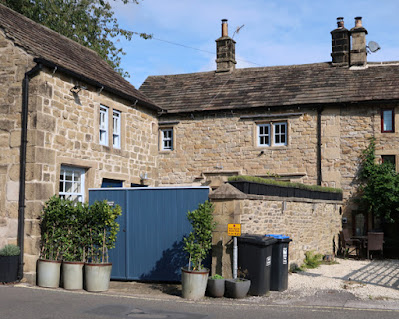The logistics of getting to St. John’s church in Ault Hucknall by public transport, with six separate bus journeys and two cross country walks, had been the most complicated since first investigating the mediaeval churches in South Yorkshire and the surrounding counties – starting in February 2016 at St. Helen’s church in Treeton back, which is 150 metres from my house.
A few days later, I set off to the village of Eyam in the Peak District National Park, which is a very popular tourist destination known as the “plague village” but which is also surrounded by some interesting geology, as I had discovered on field trips with the Sheffield U3A Geology Group.
My main objective was to visit St. Lawrence’ s church but, as as usual on my days out, I had a list of 27 buildings to photograph for the British Listed Buildings website and, alighting from the No. 65 bus at the Town Head stop a few hundred metres west of the village, I started at the Grade II Listed early C19 Eyam View Farmhouse.
This and the U-shaped range of farm buildings are built in Carboniferous Limestone, with Millstone Grit used for the quoins, the window and door surrounds and the three full height, semi-circular headed blind arches, which are its most interesting feature.
Looking at the 1883 Ordnance Survey map, the only limestone quarry in the area is set on a knoll reef within the Eyam Limestone Formation, just 200 metres to the south-east of the farm and it is likely that the stone came from here. To the north, the Upper Carboniferous Shale Grit forms a distinct escarpment and the Building Stones Database for England map explorer shows that Bretton Quarry and others worked this formation.
After photographing the other listed buildings, including two pairs of gatepiers, I headed back towards Eyam and stopped briefly at the unlisted former Townhead silk mill (1735), which is built in gritstone, before continuing along Main Road to the Olde House (1615), where gritstone is used again for walling with stone slates for the roof.
Next to the Olde House is the early C17 Merrill House, which has recently had the render removed from the front elevation, along with a C18 outbuilding that is listed for its group value only. Both are built in gritstone - presumably from the Shale Grit - with stone slate roofs and, although I occasionally saw a building constructed with Carboniferous Limestone, it is these materials that give Eyam its essential character.
At a few places on Main Road, for example the former Townend Inn, the Royal Oak and West End Cottage, although the buildings themselves aren’t particularly notable, green information boards that highlight their history have been attached to them.
Carrying on along Main Road, I passed several gritstone buildings of no great architectural merit but, where it turns into Church Street, I stopped at the Courtyard at Eyam Hall, where various shops and places to eat and drink now occupy a couple of Grade II Listed barns and an outbuilding, where both limestone and gritstone has been used for the walling.
Although tempted to rest here for a short while, with the bus service back to Sheffield running only every 2 hours, I moved on and then stopped very briefly to photograph the front of the Grade II* Eyam Hall, which dates back to the early C17.
Crossing over to the other side of Church Street, I then went to have a look at the village stocks and the old market hall, which now serves as an information centre and various wall panels provide further details of Eyam’s history.
 |
| The village stocks and old market hall |











No comments:
Post a Comment